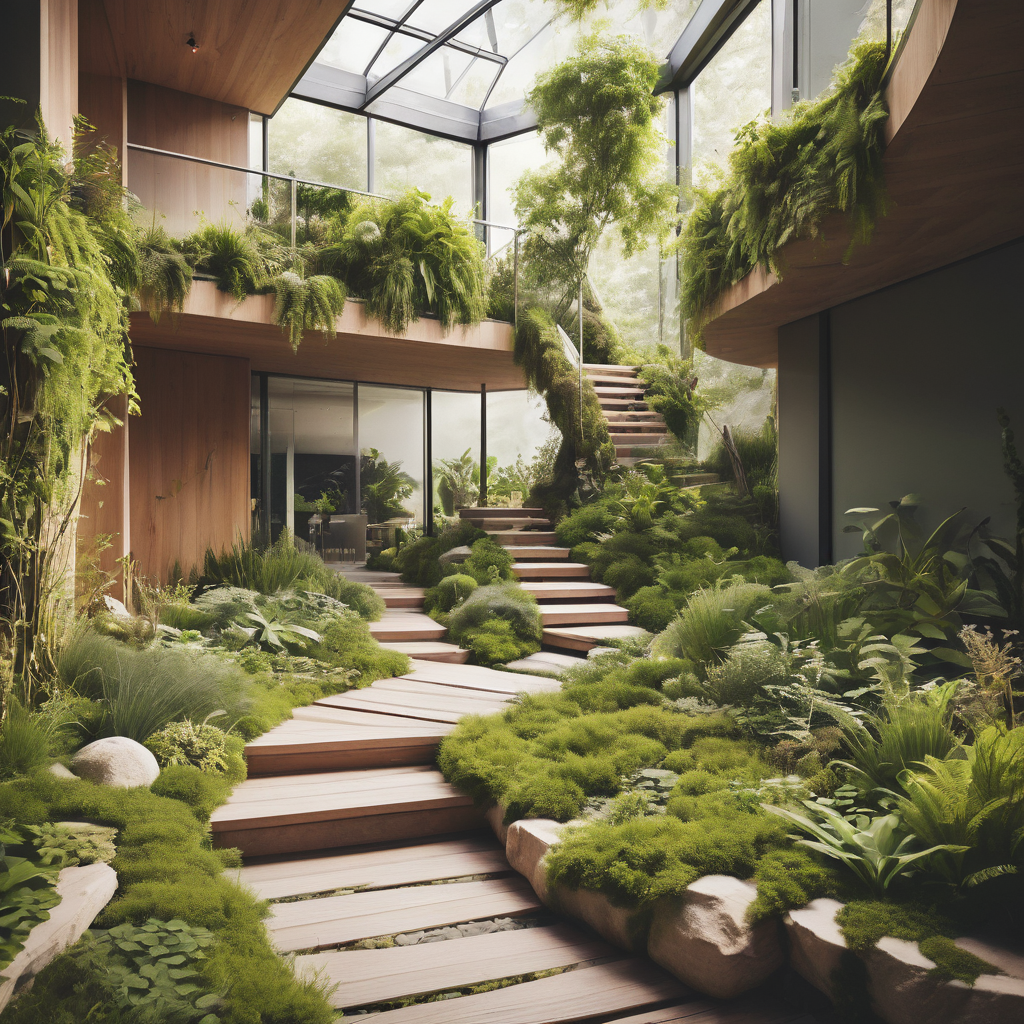Embracing Biophilic Spaces – “NATURE’S TOUCH”
Embracing Biophilic Spaces
In the midst of the urban sprawl, nature’s gentle embrace secretly offers a path to serenity and well-being, as a growing movement in architecture and interior design are seeking to bridge the gap between urban environments and the natural world by seamlessly integrating outdoor elements indoors. Biophilic design, as it’s called, is more than just a trend—it’s a philosophy rooted in our innate connection with the natural world. In this post, we’ll explore what biophilic design is, why it’s important, some fascinating historical and scientific insights, and how you can incorporate it into your home or workplace to enhance well-being.
What is Biophilic Design?
At its core, biophilic design is an innovative approach to architecture and interior design that seeks to integrate natural elements, colors and patterns into constructed environments. Coined by biologist Edward O. Wilson, the term ‘biophilia’ originates from the Greek words ‘bios,’ meaning life, and ‘philia,’ meaning love. Biophilia literally means a love of life or living things, representing humanity’s innate affinity for nature. Biophilic design harnesses this connection by incorporating features such as natural light, indoor plants, water features, and organic materials to create spaces that evoke the tranquility and beauty of the outdoors.
Why is Biophilic Design Important?
Biophilic design is not just about aesthetics—it has profound implications for our health and well-being. Studies have shown that exposure to nature or natural elements within indoor environments can reduce stress, improve cognitive function, enhance mood, and promote overall well-being. By fostering a deeper connection with nature, biophilic design creates spaces that nourish the mind, body, and spirit.
Fun Facts about Biophilic Design
- Did you know that biophilic design can trace its roots back to ancient civilizations? From the Hanging Gardens of Babylon to the zen gardens of Japan, cultures throughout history have recognized the restorative power of nature-inspired spaces.
- Biophilic design isn’t just for humans—research has shown that incorporating natural elements into animal habitats can improve their well-being and reduce stress.
- The presence of indoor plants isn’t just visually pleasing—it can also improve air quality by removing harmful toxins and pollutants from the environment.
Historical Insights
Throughout history, humans have sought to create spaces that reflect our connection with nature. From ancient cave dwellings adorned with paintings of wildlife to the grand gardens of Versailles, our built environments have always been influenced by the natural world. In the 20th century, architects such as Frank Lloyd Wright and Antoni Gaudí advocated biophilic principles in their designs, integrating natural materials and organic forms to create harmonious and immersive spaces.
Scientific Research on Biophilic Design
The scientific evidence supporting the benefits of biophilic design is compelling. Numerous studies have shown that exposure to natural elements within indoor environments can reduce blood pressure, lower stress hormones, and improve cognitive function. For example, a study conducted by researchers at Harvard University found that office workers in environments with views of nature reported higher levels of satisfaction and lower levels of stress compared to those in windowless spaces.
Research on the benefits of living and working in biophilic spaces has shown numerous positive effects on physical, mental, and emotional well-being. Here are some key findings from various studies:
- Stress Reduction: Several studies have found that exposure to nature or natural elements within indoor environments can reduce stress levels. For example, research published in the Journal of Environmental Psychology demonstrated that incorporating natural elements like plants and views of nature into workspaces led to significant reductions in stress and anxiety among office workers.
- Improved Cognitive Function: Biophilic elements in indoor spaces have been shown to enhance cognitive function, including attention span, memory, creativity, and problem-solving skills. A study published in the Journal of Environmental Psychology found that workers in offices with views of nature performed better on cognitive tasks and reported higher levels of job satisfaction compared to those in windowless or less-natural environments.
- Enhanced Mood and Well-being: Exposure to nature indoors has been linked to improved mood and emotional well-being. Research published in the Journal of Physiological Anthropology found that indoor plants can reduce psychological and physiological stress, leading to improved mood and overall well-being.
- Increased Productivity: Biophilic design has been associated with increased productivity in work environments. A study conducted by researchers at the University of Oregon found that workers in biophilic office environments reported a 15% increase in productivity compared to those in non-biophilic spaces.
- Faster Healing: Nature views and access to natural light have been shown to promote faster healing and recovery in healthcare settings. Research published in the journal Environment and Behavior found that hospital patients with views of nature outside their windows had shorter postoperative stays, required fewer pain medications, and experienced fewer complications compared to those with views of built environments.
- Reduced Symptoms of Attention Deficit Hyperactivity Disorder (ADHD): Exposure to nature indoors may help alleviate symptoms of ADHD and improve attention and focus. A study published in the Journal of Attention Disorders found that children with ADHD who spent time in green outdoor settings or indoor environments with nature views experienced improved attention and concentration compared to those in non-green settings.
The Three Principles of Biophilic Interiors
Creating a biophilic home revolves around three key principles:
- Direct Experiences: These involve physical interaction with nature, such as touching indoor plants or enjoying natural light.
- Indirect Experiences: Representations of nature, like images of forests or textures reminiscent of the natural world.
- Space and Place: This principle emphasizes creating a unified interior space, mirroring the interconnectedness found in nature, facilitating seamless navigation within your home.
Greening Your Indoor Space
In essence, biophilic design aims to create environments that promote health, well-being, and productivity by mimicking aspects of the natural world. This can include incorporating natural light, views of nature, indoor plants, organic shapes, and textures, as well as utilizing sustainable materials and practices. The ultimate goal is to create spaces that not only look visually appealing but also contribute to the physical and psychological wellbeing of our health, fostering a greater sense of harmony and connection with the environment.
The principles of biophilic design can sound a little tricky to understand if you’re not an interior expert. Luckily, you don’t have to! By looking at the different ways you can incorporate nature into your home, you can start to develop a biophilic space without professional knowledge. To help you get started, here are some easy ways to use the concept in your home.
ï Earth Tones: Opt for warm browns, soft creams, and rusty reds to infuse your space with earthy colors, effortlessly bringing natural elements indoors.
ï Plenty of Indoor Plants: Incorporate indoor plants to seamlessly blend the indoors with the outdoors, adding greenery to your space and enhancing its biophilic appeal. In addition include below is a list of easy to care for indoor plants to get you started with your biophilic space.
Here are 15 fun ways to incorporate biophilic design into your home that go beyond just potted plants:
- Maximize Natural Light: Design your space to maximize natural light by using large windows, skylights, and light-colored surfaces to reflect and distribute sunlight throughout the interior.
- Indoor Plants: Introduce indoor plants throughout your home, such as potted plants, hanging plants, or a vertical garden, to bring in elements of nature and improve air quality.
- Natural Materials: Use natural materials like wood, stone, bamboo, cork, and clay in your flooring, furniture, and decor to create a connection with the outdoors and add warmth and texture to your space.
- Biophilic Colors: Incorporate earthy tones, greens, blues, and other colors found in nature into your color palette to evoke a sense of calmness and tranquility.
- Views of Nature: Position furniture and design layout to take advantage of views of nature outside, whether it’s a garden, park, or natural landscape, to provide visual access to the outdoors.
- Water Features: Incorporate water features such as indoor fountains, ponds, or even a small tabletop waterfall to introduce the soothing sight and sound of flowing water into your home.
- Natural Patterns and Textures: Use textiles, wallpaper, and decor featuring natural patterns like leaves, flowers, or landscapes, as well as textures like wood grain or stone, to add visual interest and evoke a sense of nature.
- Living Walls: Install a living wall or greenery-covered surface indoors to create a striking focal point and improve air quality while bringing the benefits of nature directly into your living space.
- Natural Ventilation: Design your home to promote natural ventilation by incorporating features like operable windows, ventilation louvers, or breezeways to encourage airflow and reduce reliance on mechanical systems.
- Outdoor Living Spaces: Extend your living space outdoors with a patio, deck, or garden area furnished with comfortable seating, greenery, and elements that encourage outdoor activities and relaxation.
- Natural Sounds: Incorporate natural sounds into your home environment, whether it’s through wind chimes, bird feeders outside windows, or a sound machine with recordings of nature sounds like waves or birdsong.
- Organic Shapes: Choose furniture, decor, and architectural elements with organic, flowing shapes and curves inspired by nature, rather than rigid geometric forms, to create a more harmonious and inviting atmosphere.
- Natural Artwork and Photography: Decorate your walls with artwork and photography featuring natural landscapes, wildlife, or botanical motifs to bring the beauty of nature indoors and create visual interest.
- Sustainable Design Practices: Embrace sustainable design practices such as energy-efficient lighting, passive solar design, recycled or reclaimed materials, and water-saving fixtures to minimize environmental impact and align with biophilic principles.
- Personal Connection to Nature: Incorporate personal items from nature, such as shells collected from the beach, stones from a hiking trip, or artwork created from natural materials, to create a meaningful connection to the outdoors within your home.
Indoor Plants for Low Light and Air Quality Improvement
- Snake Plant (Sansevieria): Known for its resilience and air-purifying qualities, the snake plant thrives in low light conditions.
- Spider Plant (Chlorophytum comosum): Spider plants are adaptable and excellent air purifiers, making them perfect for low light environments.
- ZZ Plant (Zamioculcas zamiifolia): ZZ plants are extremely low maintenance and can tolerate low light and infrequent watering.
- Pothos (Epipremnum aureum): Pothos is a trailing vine that thrives in low light and helps improve indoor air quality.
- Peace Lily (Spathiphyllum): Peace lilies are renowned for their air-purifying abilities and can bloom in low light conditions.
- Chinese Evergreen (Aglaonema): Chinese evergreens come in various colors and patterns and are tolerant of low light and dry conditions.
- Parlor Palm (Chamaedorea elegans): Parlor palms are compact and well-suited for low light conditions, making them ideal for small spaces.
- Dracaena (Dracaena spp.): Several varieties of Dracaena, such as the Janet Craig and Marginata, thrive in low light conditions and require minimal care.
- Philodendron (Philodendron spp.): Philodendrons are adaptable and come in various shapes and sizes, making them suitable for low light environments.
- Lucky Bamboo (Dracaena sanderiana): Lucky bamboo is a popular plant in feng shui and can grow in low light with just water and occasional fertilization.
Minimalist Indoor Herb Garden
If creating such a large indoor biophilic space isn’t quite your style, you might want to consider something more practical, like an indoor herb garden, which offers all the rewards and benefits of a biophilic well-being space.
An indoor countertop biophilic herb space offers numerous benefits, including a direct connection with nature through daily interaction with plants, stress reduction from therapeutic gardening activities, and improved indoor air quality thanks to the natural air-purifying properties of herbs. Additionally, having fresh herbs readily available in the kitchen enhances culinary experiences while stimulating multiple senses with vibrant colors, fragrant aromas, and varied textures.
From a design perspective, creating an indoor herb garden aligns with biophilic design principles, enhancing the kitchen’s aesthetic appeal and fostering a sense of connection with the outdoors, ultimately promoting overall well-being and vitality in the home environment with all the bonus of enjoying fresh organic herbs into your cooking.
In conclusion, incorporating biophilic design principles into your home is more than just a trend—it’s a transformative journey towards enhanced well-being and connection with nature. By embracing natural elements such as light, plants, and organic shapes, you can create spaces that not only look visually appealing but also nurture your physical and psychological health. From stress reduction and improved air quality to sensory stimulation and educational opportunities, the benefits are abundant. Whether it’s through a simple indoor herb garden or a comprehensive redesign of your living space, every step towards biophilic living brings you closer to a harmonious relationship with your environment and a greater sense of vitality and well-being.
So why wait? Start your biophilic journey today and experience the transformative power of nature within your own home
((Include two or three quotes in the layout.))
“Biophilic design is not just about spaces; it’s about reconnecting hearts to the heartbeat of the earth.” – Unknown
“In the dance between nature and architecture, let harmony be our guiding rhythm.” – Unknown
“In the embrace of biophilic design, our homes become sanctuaries where the soul finds solace.” – Unknown
“Through the lens of biophilic design, we discover that beauty lies not just in form, but in the essence of life itself.” – Unknown




